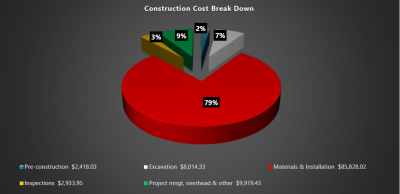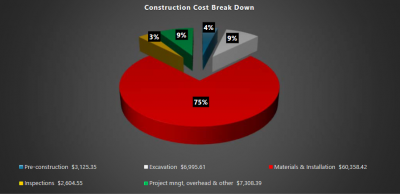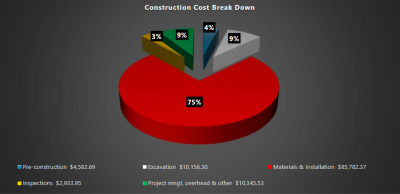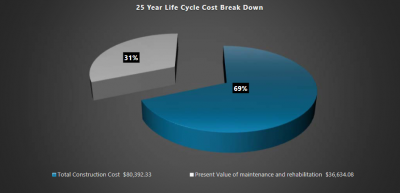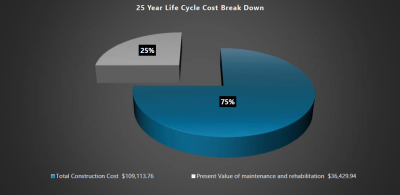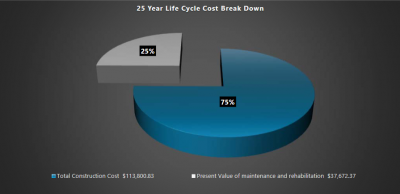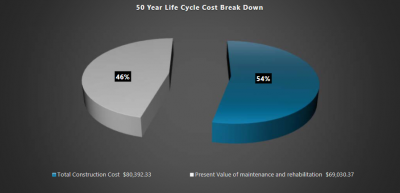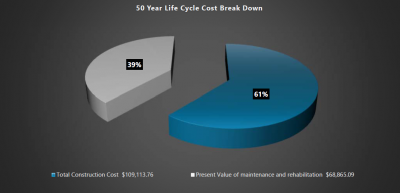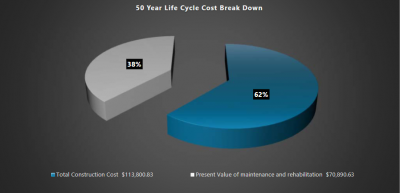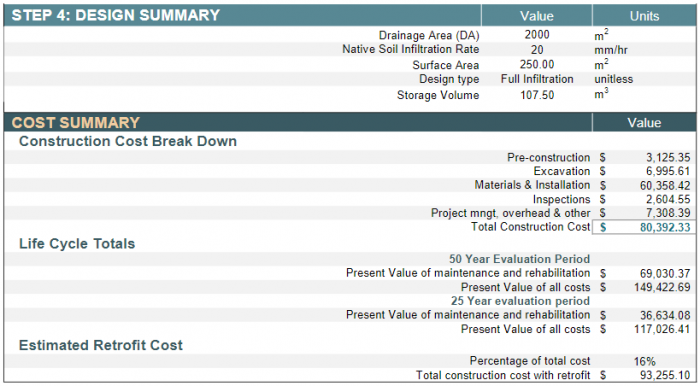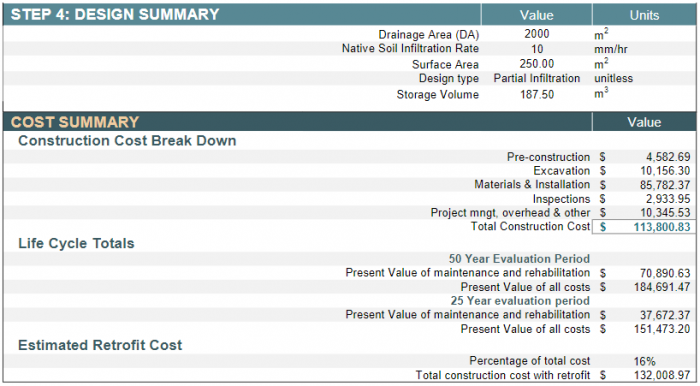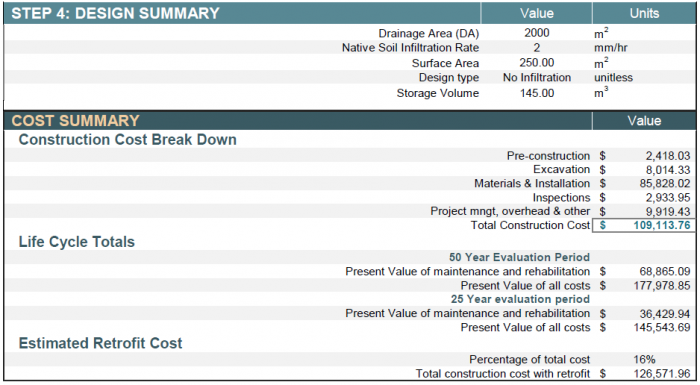Difference between revisions of "Bioretention: Life Cycle Costs"
Dean Young (talk | contribs) |
Dean Young (talk | contribs) |
||
| Line 19: | Line 19: | ||
* An underdrain (200 mm diameter perforated pipe) is included in Partial Infiltration and No Infiltration design configurations only. | * An underdrain (200 mm diameter perforated pipe) is included in Partial Infiltration and No Infiltration design configurations only. | ||
=== | ===Notes=== | ||
* Designs include [[pretreatment]] through stone diaphragms at [[Curb cuts|curb inlets]] and two inlet structure sumps (Rain Guardian bunkers). | * Designs include [[pretreatment]] through stone diaphragms at [[Curb cuts|curb inlets]] and two inlet structure sumps (Rain Guardian bunkers). | ||
* Operation and maintenance cost estimates assume rehabilitation of the filter media bed surface is required after 25 years of operation. | * Operation and maintenance cost estimates assume rehabilitation of the filter media bed surface is required after 25 years of operation. | ||
Revision as of 19:37, 14 December 2022
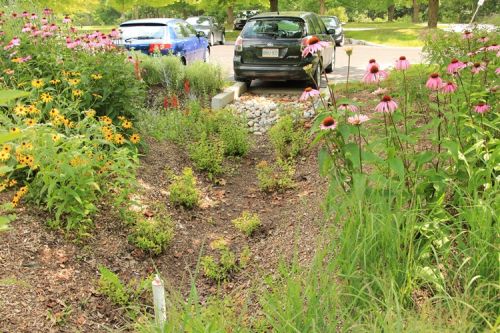
Overview[edit]
Given that Bioretention is a widely used name and a general "catch-all" term for most vegetated LID practices that temporarily store stormwater runoff in depressed planting beds there are a number of configurations of the feature that can be used in various contexts and environments. Depending on native soil infiltration rate and physical constraints, the facility may be designed without an underdrain for full infiltration, with an underdrain for partial infiltration, or with an impermeable liner and underdrain for no infiltration/filtration only (i.e., a stormwater planters or biofilter) design. STEP has prepared life cycle costs estimates for each design configuration, based on a runoff control target of 25 mm depth and 72 hour drainage period, for comparison which can be viewed below. To generate your own life cycle cost estimates customized to the development context, design criteria, and constraints applicable to your site, access the updated LCCT Tool here.
Design Assumptions[edit]
Bioretention is an ideal technology for fitting functional vegetation into urban landscapes and treating runoff collected from nearby impervious surfaces.
Components include: a 'filter bed' with filter media, storage layer of reservoir aggregate, planting and a finishing surface layer of mulch and/or stone.
Additional components include an underdrain to remove excess water and soil additives to enhance pollutant removal.
Design assumptions are based on tool default values and STEP recommendations:
- Maximum impervious drainage area to permeable surface area (I:P area) ratio of 20:1.
- Length to width ratio of bioretention area is 10:1.
- Default filter media depth of 1.0 metres to accommodate trees in planting plan.
- Default mulch depth of 75 millimetres.
- An underdrain (200 mm diameter perforated pipe) is included in Partial Infiltration and No Infiltration design configurations only.
Notes[edit]
- Designs include pretreatment through stone diaphragms at curb inlets and two inlet structure sumps (Rain Guardian bunkers).
- Operation and maintenance cost estimates assume rehabilitation of the filter media bed surface is required after 25 years of operation.
- The tool calculates costs for new (greenfield) development contexts and includes costs for contractor overhead and profit, material, delivery, labour, equipment (rental, operating and operator costs), hauling and disposal.
- Mobilization and demobilization costs are not included, assuming BMP construction is part of overall development site construction with equipment needed already on-site.
- Design and Engineering cost estimates are not calculated by the tool and must be supplied by the user.
- The tool adds 10% contingency and additional overhead as default.
- All cost estimates are in Canadian dollars and represent the net present value (NPV) as the tool takes into account average annual interest and discount rates over the 25 and 50 year operating life cycle periods.
- Unit costs are based on 2018 RSMeans standard union pricing.
- Additional costs associated with retrofit or redevelopment contents is assumed to be 16% higher than the cost for new (greenfield) development contexts.
- Retrofit construction cost estimates are included in the 'Costs Summary' section for comparison.
- Retrofit construction cost estimates are included in the 'Costs Summary' section for comparison.
Construction Costs[edit]
Note: Please click on each image to enlarge to view associated construction cost estimates.
Above you can find construction cost breakdowns for 250 m2 surface area facilities (I:P area ratio of 8:1) for each design configuration:
As can be seen the greatest cost for this practice (regardless of configuration type) will be Material & Installation, which includes costly components such as the impermeable membrane/liner appropriate planting and vegetation selection, underdrain, filter media and the stone storage layer or Internal water storage zone (IWSZ).
Life Cycle Costs[edit]
Below are both the capital and life cycle costs of the three bioretention configuration practices over a 25 and 50-year time horizon based on a detailed assessment of local input costs, maintenance requirements, rehabilitation costs and design scenarios relevant to Canadian climates. The estimates of maintenance and rehabilitation (life cycle) costs represent net present values.
Looking at the pie charts below for each configuration we can see that they are all relatively close to being the same cost with a variation of a few hundred dollars between each over both a 25 and 50-year time horizon. The percentage of the Full Infitlration configuration is greater than the other two due to the lesser cost of the overall installation for material and Installation, (no underdrains, no gravel storage layer or impermeable membrane, etc.).
25-Year life cycle cost break down[edit]
Note: Click on each image to enlarge to view associated life cycle cost estimate.
50-Year life cycle cost break down[edit]
Note: Click on each image to enlarge to view associated life cycle cost estimate.
Total Cost & Design Summary[edit]
As previously discussed the three Bioretention configurations total cost summary vary greatly dependent on whether you want you feature to possess full infiltration, no infiltration, or partial infiltration. In short, the most expensive of these options is the Bioretention: Partial infiltration option ($113,800.83 vs. $109,113.76 - no infiltration and $80,392.33 - full infiltration). The same can be said for construction + associated retrofit costs with each configuration design ($132,008.97 vs. $126,571.96 - no infiltration and $93,255.10 - full infiltration) This configuration allows for the greatest storage volume (187.5 m3) compared to its counterparts at 1453 for no infiltration and 107.53 for full infiltration; all while having the exact same surface area footprint of 250m2. As reminder, it is important to understand your site's surrounding native soil infiltration rate to ensure you are selecting the appropriate design.
A final note regarding the accuracy of the LCCT. A follow up sensitivity analysis study was conducted by CVC & STEP back in 2019 to test the tool's accuracy. The analysis took designs from 6 completed projects (4 bioretention, 1 permeable pavement, and 1 infiltration trench), and ran them through the tool comparing construction costing results from the LCCT to actual construction costs for the projects. The accuracy target set for the tool was plus-or-minus 30% of actual construction costs.
The analysis found that the tool was on average (±14%) to actual construction costs[2]
Full Infiltration[edit]
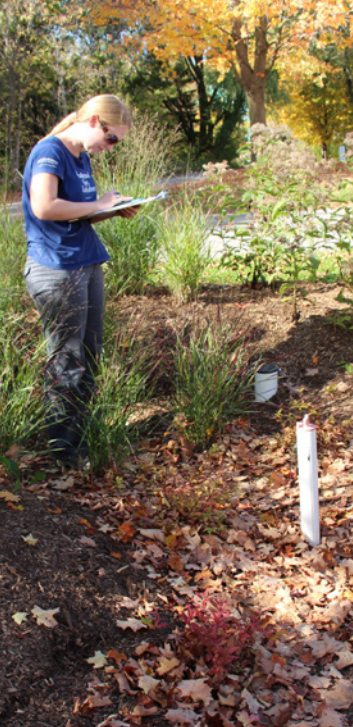
Partial Infiltration[edit]
Non-Infiltrating/filtration only[edit]
References[edit]
- ↑ Performance Comparison of Surface and Underground Stormwater Infiltration Practices TECHNICAL BRIEF. Accessed Dec 12 2022. https://sustainabletechnologies.ca/app/uploads/2016/08/BioVSTrench_TechBrief__July2015.pdf
- ↑ Credit Vally Conservation (CVC). 2019. Life-cycle costing tool 2019 update: sensitivity analysis. Credit Valley Conservation, Mississauga, Ontario. https://sustainabletechnologies.ca/app/uploads/2020/04/LCCT-Sensitivity-Analysis_March2020.pdf
- ↑ Performance Comparison of Surface and Underground Stormwater Infiltration Practices - TECHNICAL BRIEF. Low Impact Development Series. https://sustainabletechnologies.ca/app/uploads/2016/08/BioVSTrench_TechBrief__July2015.pdf
